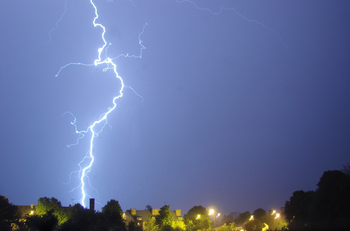The key concept to defining plasma is the Debye distance/length/radius. If the particles are so close the Debye distance plays little or no role in particle interaction, than it is not a plasma. This Debye distance depends on the charge of the particles, so if their is no charge...
Though temperatures like 3,000 Fahrenheit would force a separation between particles of a gas to distances on the order of the Debye, for a solid, like lava, this is not the case.
Fire is a very small presence of plasma under the pressure of 100 kPa, so it does not exist much for long, if at all.
Of course lightning "has a frequency component". If it didn't have non-zero frequencies, it could never start or would last indefinitely.
Lightning is a huge current pulse over a short time, usually several pulses over a few milliseconds. But more importantly, the current is started and stopped very abruptly, which by necessity means it has a broad spectrum containing significant high frequency content.
Spark gaps in general are infamous for being broad band frequency sources well into the radio range. Some early radio transmitters harnesses this by connecting a spark gap to a resonant circuit. Since the spark gap produced a wide spectrum, it also produced the frequency of the resonance. However, the other frequencies aren't sufficiently attenuated, so spark gap transmitters are specifically banned in the US (probably most countries).
I think your question really comes down to a unawareness of Fourier analisys. That would be a good search term to look up additional information.


Best Answer
I think it can be interesting to answer both questions and add a few interesting details to the answer already given.
The zig-zag line is a sort of optical illusion, if you watch the slow motion of a ligtning on YT here at 3:04 or here from 0.45 to 0.51, you will see that the real path looks like the course of a river. Each discharge is a series of steps in which the current travels a short distance and then pauses: each pause is where we see a change in direction. Meanwhile the local potential to ground is changing, so the final target is constantly changing.
As the discharge approaches the earth, many potential targets might be seen, but only one or a few will ionize the local air enough to provide the final path to ground, a small discharge can be seen coming from objects that were failed targets, and there is upward lightning. That explains also why the zig-zag line is not perpendicular to the ground.
You can compare the actual course of the lightning in the above picture 10.3 with the picture you get with an ordinary camera or with the eye:
The secondary branches are only temporary and in different directions, but they remain impressed on the retina at the real flow of time.